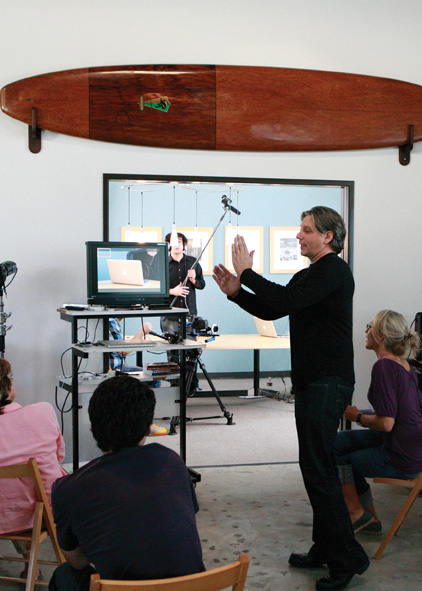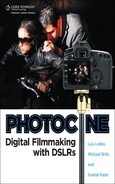
In March 2011, a new live video for the song “Fucking” from the band Scars on Broadway was created with a audacious approach by photographer Greg Watermann. One man, one camera, and an innovative idea on how to execute what is usually a five-camera job. I caught up with Greg in Los Angeles to get a glimpse of his method. What I found is a new paradigm for creating live music videos.
The band Scars on Broadway was founded by System of a Down (SOAD) members Daron Malakian and John Dolmayan in 2008. Photographer Greg Watermann has been SOAD’s photographer for nine years, so when Malakian asked Watermann to shoot the Scars on Broadway show at the Avalon in Los Angeles, Watermann was looking to do something beyond still photography. However, Watermann knew that he couldn’t produce an experimental vignette for a brand new song. It was a song that had not been officially released, and that had only made its way to the Scars on Broadway fans a week earlier via the band’s website. So he started thinking way outside of the norm for a way to produce something exceptional on an extremely tight budget.
Whereas most bands demand that the music in a video not be touched by any external sounds, like fans singing in line, Watermann knew that Scars on Broadway were nonconformists and might be open to his vision of including the improvisation of fans singing the chorus. Indeed, bringing the band something standard would probably get the video rejected.
The second challenge was capturing enough footage to create a powerful video with only one camera and one operator. Watermann focused on shooting as much as he possibly could. As you watch the video, which you can download from their website (http://www.scarsonbroadway.com) or from YouTube, you can see that this made for an exhausting night. Also, with the song only two minutes long, how did he cover all those angles? To do it all, Watermann had to collaborate with master editor, Ben Darling.
If you look at the video close enough, you’ll see that there is footage that syncs with the music played that night at the Avalon, but also you’ll see other footage that was captured from other performances...of different songs. This was a no-budget video being shot and directed by a veteran with a phenomenal reputation to uphold. Watermann had to stretch beyond the confining bounds of normalcy and standard production. He intelligently improvised.
Editor Ben Darling executed Watermann’s vision and ideas flawlessly. Darling scoured other footage of the band to find visual movement that closely matched the music of the live performance of the song at the Avalon. He then cut that in with the actual footage captured that evening to produce the convincing effect that you see.
Watermann knew that the fans would pick up on technique. He readily admits to his process. He has far too much respect for the fans to not be transparent with his method. In fact, the fans were part of the motivation for choosing this particular song for his video. He wanted to give the committed supporters of the band an awesome video of a song that only they knew about.
Watermann went to Scars on Broadway to get approval to release the video. They agreed. The video went live on YouTube on the 13th of March. As of this writing, there are over 90 thousand views. Since the video’s release, Watermann has already been swooped into meetings with Sony Music. With YouTube as the number one destination for people to listen to music, the music video has become the new album cover. If a video engages the viewers in the first 10 seconds, they are likely to seek out the song and potentially more music from the band.
Like the band he shoots, Greg Watermann took a nonconformist’s look at the norms and innovated his way into the next tier of his career. He also had the wherewithal to find the right editor to round out the project. I’ve watched the video a half a dozen times now, and I’m still reeling over Ben Darling’s work; it is brilliant.
Watermann has not only pioneered a new video-creation method that can survive the struggling budgets of the music industry, he has also shown that there are significant benefits for thinking outside the conventional and doing it yourself. However, what Watermann didn’t anticipate was that he would have to find a way to elevate himself over his own bar.
The paradigm shift that Watermann pioneered had overnight become the standard expectation from other incredibly high-profile artists like Toby Keith, Pitbull, and Marc Anthony. It was a cliché case of wow, look what I did—oh, no, I have to do it again?
That was the rub. Watermann had been shooting System of a Down and Scars on Broadway for years. He knew them and they knew him. The trust had been well established. Now with all these other high-end bands reaching out to Watermann, he was going to be without this familiarity, which was a significant factor in the success of the Scars video.
Another looming pressure was that while Watermann’s first video hit 90,000 views in a few weeks, anything he did now was going to have that many views in the first few hours. Everyone was going to be watching his next move. The disruption of the new had been replaced by the expectation of the next.
Watermann was also learning as he was going. Not only about the technological aspects of what he was doing in motion, but also he was getting a sense of what the musical stars wanted. With massive overnight success comes an almost immediate compulsion to go big with production. Just look at any small indie movie that skyrockets. And then look at the sequel. It loses its, well, whatever it is that gives it originality because a bunch of money and production gets thrown at it, which can have the effect of breeding second guesses and a loss of a clear vision.
It was the audacious approach that got Greg Watermann to where he was sitting.
For the last 15 years, System of a Down has been documenting their evolution as a band. The creative director and the director of many of the SOAD videos is Shavo Odadjian, the bass player of the band. When Watermann was asked to go on tour with the band, it was to shoot stills and video and to collaborate with Shavo on visuals.
To get a feel for the creative prowess of Shavo, have a look at the System of a Down video Aerials. As Watermann puts it, when he’s in a creative brainstorming session with Shavo, Watermann feels like he’s drizzling ideas to Shavo’s hurricane.
The SOAD tour went through the United States, Europe, and Russia. Watermann stood by his guns—one man, one camera. The results were awesome. The tour also served to give Watermann more experience with his one-man method. He also collaborated closely with his editor, which is key to his creative method.
His next gig was to bring to bear all the pressure of Watermann’s new celebrity DP/Director status. When he got back to the States, he was already booked to work with Pitbull and Marc Anthony. It was another superstar act, but Watermann had never worked with them before.
As Greg was getting embedded with his new gig, he was starting to see something emerge. The superstars enjoyed the loose spontaneity of what he was doing. And his work was getting approved on delivery. Moreover, his footage and stills that were off-the-cuff were getting picked up for advertising campaigns. An image that Watermann shot while working with Pitbull was used in a Voli Vodka campaign. Before Watermann had a chance to swap camera cards, his image was two stories high on Times Square, New York.
Waterman’s style was also resulting in a wave of advertising gigs. At the spectacular Fontainebleau hotel in Miami, Watermann shot Pitbull throughout the hotel for a Voli vodka ad campaign. Pitbull appreciated that Watermann was working solo. It allowed for a lot of spontaneity in contrast to Pitbull’s heavily orchestrated days. Again, Watermann’s efforts were approved immediately.

The Voli Vodka campaign in Times Square
But it was the response to Watermann’s behind-the-scenes piece that he shot on the set of the Pitbull, Marc Anthony video for Rain Over Me that really spun his head. Greg put together an edited piece of his video and showed it to Pitbull. It was on its way to CNN an hour later. The video is to be used as a teaser for the hugely anticipated music video. I’ve just had a sneak peek at the piece. It’s fabulous.
Greg Watermann never went to film school, nor did he formally learn how to make films. As near as I can tell, there are three prevailing and compelling reasons for his meteoric success.
The first, and probably the most important, is that he knows the music industry. He has been around it, shooting as a photographer for his entire career. Knowing your environment is a huge advantage.
Second, he’s fearless. He had a vision, and he set forth to execute it with the skills that he possessed. What anyone else thought, he didn’t care. The notions of needing a budget and a crew and a lot of stuff or even the right gear weren’t barriers for him.
Last, he knows a good wave when he sees it. When the first Scars on Broadway video started blossoming into more opportunities, he didn’t freeze up and start over thinking his position. He stayed true to what he knew and expanded upon it.
